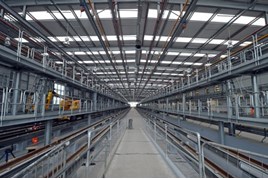Three Bridges depot has capacity for 172 vehicles on its 11 stabling roads. In the heavy/light maintenance roads there is capacity for one 12-car train in the former and four 12-cars in the latter. The underframe cleaning facility can house a further four 12-car trains. The Controlled Emission Toilet (CET)/cleaning roads can also house 172 vehicles. The wheel lathe features a new tandem head lathe. The carriage wash machines can operate at temperatures as cold as -3°C. The main shed has two bogie drops in tandem configuration.
The site is fully signalled with power-operated points and depot protection. There are also point heaters, meaning that they won’t freeze in cold conditions. The depot is served by 750V DC third rail, but there is also a 25kV overhead line equipment (OLE) test rail within the main shed. Trains cannot move under their own power using that, but can draw power there. This is purely for testing, Humphrey tells RAIL.
Walking around the depot, Humphrey points out various elements of the facility. The stabling sidings on the Up side of the depot are huge - they need to be, to accommodate two 12-car trains. Each ‘700/1’ is 240 metres in length.
At the south end of the Up Sidings is the carriage wash. This is bi-directional and includes the facility to blow water from the trains, which stops the doors from freezing. Every train arriving at the site will pass through here.
There is access to the depot at each end of the site, although there are problems getting from the Down Sidings to the Up Sidings across the Brighton Main Line.
At the wheel lathe, there is a double-headed lathe housed within the single-road shed. It can treat one train at a time. Humphrey explains: “The first autumn will be the issue. If you have congealed leaf that will be the problem, or if the track is not how it should be. There is a crane in case you need to lift.”
She explains that the modification required at the Hornsey facility is a small clamping device to enable the ‘700s’ to be treated there. That facility will be open to other train operating companies, although GTR will have priority.
Inside the 263 metre-long main shed at Three Bridges there are five maintenance roads, plus one in the stores shed.
The latter is used for the bogie drop that enables defective bogies to be removed. There are no lifting jacks because of the two bogie drops, but there is passive provision in place if Siemens decides to install them. Bogie overhauls are not carried out at Three Bridges (it’s about the only work that isn’t!) Instead the bogies are shipped back to Siemens’ facility in Graz (Austria).
The depot is designed for Class 700s, but on the prospect of other trains using them, Humphrey says: “Who knows the future?”
Testing the depot has involved a GTR Class 387/1. This was built by Bombardier, but will not be maintained at the depot.
There is no third rail in the shed, instead a shore supply is used to power the ‘700s’.
Inside the control room, which sits in the administration block attached to the main shed, there is a control panel that shows the entire depot. One controller will operate it.
Humphrey says that access to and from the depot requires a handshake (the driver and shunter need to shake hands before the train can leave). The neighbouring Three Bridges ROC does not control the depot, only the NR routes to the access points.
After many years of infrastructure work, the Thameslink scheme is taking shape as the trains near arrival and their depot opens soon. This is merely the next step in the Thameslink project - it won’t be the last.
- This feature was published in RAIL 774 on May 13 2015
















Login to comment
Comments
No comments have been made yet.